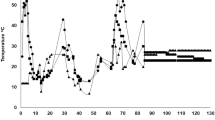Abstract
Olive-mill wastewaters (O.M.W.) were composted with wheat straw in a forced aereation static pile (7.5 × 2.5 × 1.8 m). To eliminate most of the liquid component and to degrade lignin, the thermophilic phase was prolonged for 5–6 weeks, adding O.M.W. every three days. At the end of the process, the ratio O.M.W./ solid substrate was about 10 litres per kg of straw. This paper discusses the bioremediation process from the standpoint of ligninolysis, humification, phenol degradation, phytotoxicity and agronomic value. The end product presented a degree of humification of 78%, and a residual lignin content of 30%. Soluble lignin fraction, made evident during the thermophilic phase, decreased during compost maturation. No phenols or phytotoxicity were detected in the end product. Pot and field experiments performed on maize, rye grass and horticultural plants indicated that bioremediated O.M.W. are able to support partially or totally the nutritional needs of cultures, at the same time improving soil properties.
Access this chapter
Tax calculation will be finalised at checkout
Purchases are for personal use only
Preview
Unable to display preview. Download preview PDF.
Similar content being viewed by others
References
Balice V., Carrieri C., Liberti L., Passino R., Santori M. (1965). Trattamento biologico abbinato anaerobico-aerobico delle acque di vegetazione. Ingegneria Sanitaria 2, 69.
Brink R.H., Dubach P. and Linch D.L. (1960). Measurement of carbohydrates in soil hydrolyzates with anthrone. Soil Sci 89: 157–166.
Galli E., Pasetti L., Volterra E. and Tomati U. (1994). Lignin degradation and humification during wheat straw olive mill wastewater composting. 7th International Meeting of the International Humic Substances Society, 3–8 July 1994, St. Augustine, Trinidad & Tobago, H–14.
Hageman R.H. and Huchlesby D.P. (1971). Nitrate reductase from higher plants. In: Methods in Enzymology (San Pietro A. ed), Academic Press New York and London. Vol. XXIII A, pp. 491–497.
Hesse P.R. (ed)(1971). A textbook of soil chemical analysis. W. Clowes and Sons Limited, London, Beccles, Colchester.
Kirck T.K. and Chang H.M. (1975). Decomposition of lignin by white-rot fungi. 2. Characterization of heavily degraded lignins from decayed spruce. Holzforschung, 29, 56–64.
Lanzani A. and Fedeli E. (1986). Composizione e utilizzazione delle acgue di vegetazione. In Tavola rotonda: Lo smaltimento delle acque reftue dei frantoi (Accademia Nazionale dell’Olivo, ed.). Arti grafiche Panetto & Petrelli, Spoleto. pp. 15–28.
Moore W.E. and Johnson D.B. (1967). Procedures for the chemical analysis of wood and wood products. Forest Products Laboratory, U.S. Department of Agriculture, Madison. Wisc.
Sandmann G. and Boger P. (1983). The enzymological function of heavy metals and their role in electron transfer processes of plants. In: Encyclopedia of Plant Physiology (A. Pirson and M.H. Zimmermann, eds) Springer-Verlag Berlin Heidelberg New York Tokyo, New Series, Vol. 15B, pp 563–596.
Senesi N. (1989). Composted materials as organic fertilizers. The Science of the Total Environment, 81/82, 521–542.
Tomati U. and Galli E. (1992). The feltilizing value of waste waters from the olive processing industry. In: Humus, its structure and role in agriculture and environment (J. Kubat. ed), Elsevier Science Publisher B.Y., pp 117–126.
Tomati U., Galli E., Pasetti L. and Volterra E. (1995). Bioremediation of olive-mill wastewaters by composting. Waste Management & Research (in press).
Zucconi E, Forte M., Monaco A. and De Bertoldi M. (1981) Biological evaluation of compost maturity. BioCycle 22(4): 27–29.
Author information
Authors and Affiliations
Editor information
Rights and permissions
Copyright information
© 1996 Springer Science+Business Media Dordrecht
About this chapter
Cite this chapter
Tomati, U., Galli, E., Pasetti, L., Volterra, E. (1996). Olive-mill Wastewater Bioremediation: Evolution of a Composting Process and Agronomic Value of the End Product. In: de Bertoldi, M., Sequi, P., Lemmes, B., Papi, T. (eds) The Science of Composting. Springer, Dordrecht. https://doi.org/10.1007/978-94-009-1569-5_61
Download citation
DOI: https://doi.org/10.1007/978-94-009-1569-5_61
Publisher Name: Springer, Dordrecht
Print ISBN: 978-94-010-7201-4
Online ISBN: 978-94-009-1569-5
eBook Packages: Springer Book Archive




